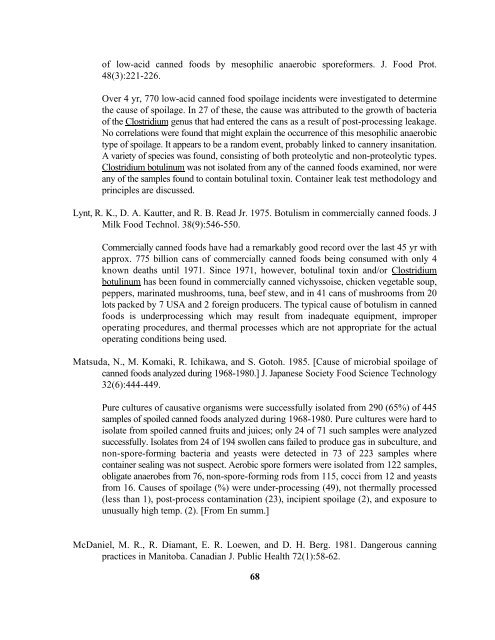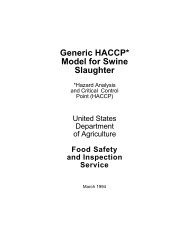Generic HACCP Model for Thermally Processed Commercial
Generic HACCP Model for Thermally Processed Commercial
Generic HACCP Model for Thermally Processed Commercial
Create successful ePaper yourself
Turn your PDF publications into a flip-book with our unique Google optimized e-Paper software.
of low-acid canned foods by mesophilic anaerobic spore<strong>for</strong>mers. J. Food Prot.<br />
48(3):221-226.<br />
Over 4 yr, 770 low-acid canned food spoilage incidents were investigated to determine<br />
the cause of spoilage. In 27 of these, the cause was attributed to the growth of bacteria<br />
of the Clostridium genus that had entered the cans as a result of post-processing leakage.<br />
No correlations were found that might explain the occurrence of this mesophilic anaerobic<br />
type of spoilage. It appears to be a random event, probably linked to cannery insanitation.<br />
A variety of species was found, consisting of both proteolytic and non-proteolytic types.<br />
Clostridium botulinum was not isolated from any of the canned foods examined, nor were<br />
any of the samples found to contain botulinal toxin. Container leak test methodology and<br />
principles are discussed.<br />
Lynt, R. K., D. A. Kautter, and R. B. Read Jr. 1975. Botulism in commercially canned foods. J<br />
Milk Food Technol. 38(9):546-550.<br />
<strong>Commercial</strong>ly canned foods have had a remarkably good record over the last 45 yr with<br />
approx. 775 billion cans of commercially canned foods being consumed with only 4<br />
known deaths until 1971. Since 1971, however, botulinal toxin and/or Clostridium<br />
botulinum has been found in commercially canned vichyssoise, chicken vegetable soup,<br />
peppers, marinated mushrooms, tuna, beef stew, and in 41 cans of mushrooms from 20<br />
lots packed by 7 USA and 2 <strong>for</strong>eign producers. The typical cause of botulism in canned<br />
foods is underprocessing which may result from inadequate equipment, improper<br />
operating procedures, and thermal processes which are not appropriate <strong>for</strong> the actual<br />
operating conditions being used.<br />
Matsuda, N., M. Komaki, R. Ichikawa, and S. Gotoh. 1985. [Cause of microbial spoilage of<br />
canned foods analyzed during 1968-1980.] J. Japanese Society Food Science Technology<br />
32(6):444-449.<br />
Pure cultures of causative organisms were successfully isolated from 290 (65%) of 445<br />
samples of spoiled canned foods analyzed during 1968-1980. Pure cultures were hard to<br />
isolate from spoiled canned fruits and juices; only 24 of 71 such samples were analyzed<br />
successfully. Isolates from 24 of 194 swollen cans failed to produce gas in subculture, and<br />
non-spore-<strong>for</strong>ming bacteria and yeasts were detected in 73 of 223 samples where<br />
container sealing was not suspect. Aerobic spore <strong>for</strong>mers were isolated from 122 samples,<br />
obligate anaerobes from 76, non-spore-<strong>for</strong>ming rods from 115, cocci from 12 and yeasts<br />
from 16. Causes of spoilage (%) were under-processing (49), not thermally processed<br />
(less than 1), post-process contamination (23), incipient spoilage (2), and exposure to<br />
unusually high temp. (2). [From En summ.]<br />
McDaniel, M. R., R. Diamant, E. R. Loewen, and D. H. Berg. 1981. Dangerous canning<br />
practices in Manitoba. Canadian J. Public Health 72(1):58-62.<br />
68



